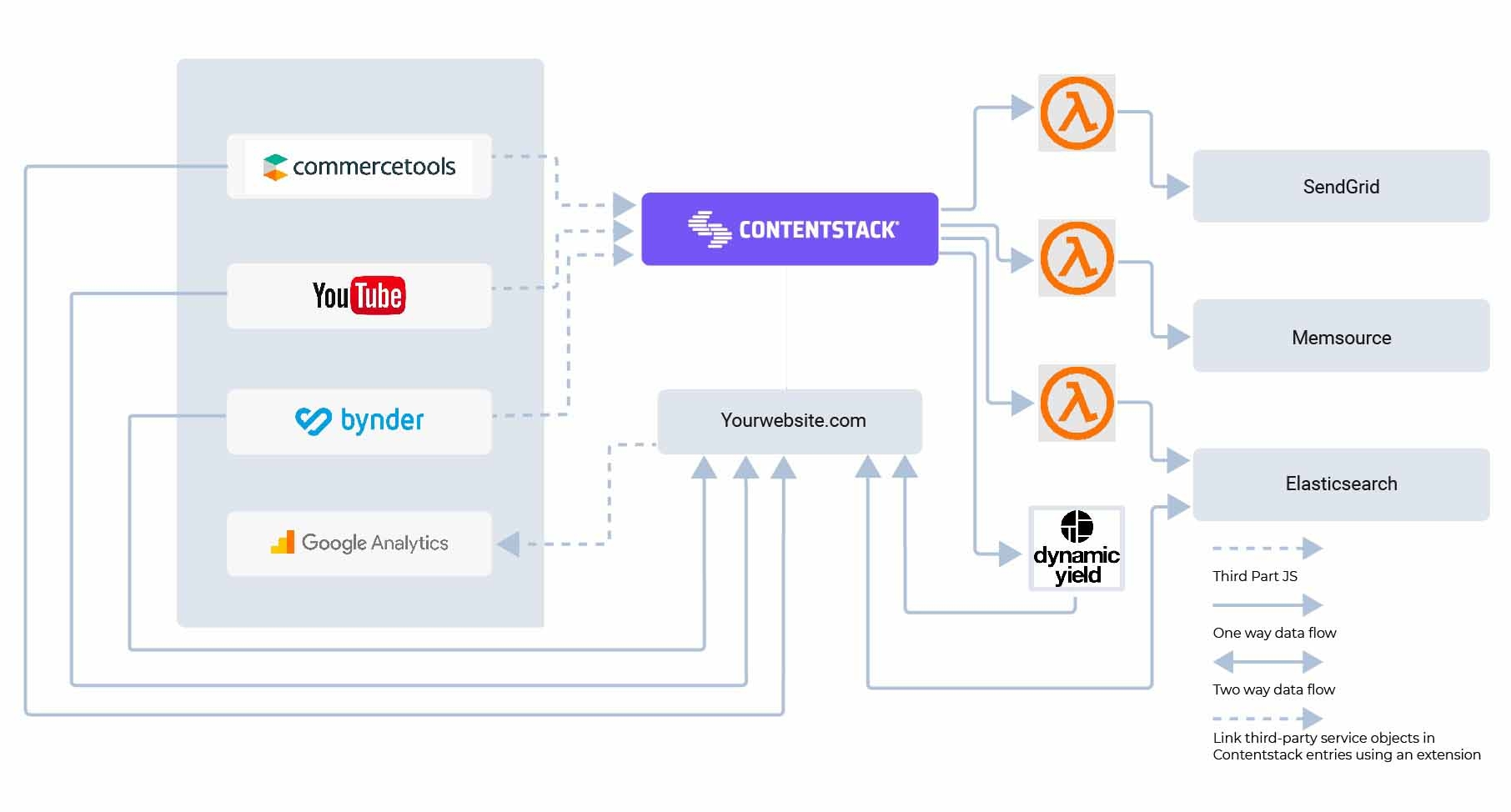Simplify e-commerce with this composable commerce cheat sheet

Discover the flexibility and scalability of composable commerce with our composable commerce cheat sheet. Learn how modular systems, MACH principles and personalized tools increase agility, efficiency and user experience.
Highlights
You’ll learn about the benefits of going composable:
- Adaptability: Make changes using a modular architecture and add new tools without overhauling your system
- Scalability: It can expand your operational capacity to handle increased demand and organizational growth
- Efficiency: The approach uses only essential tools to reduce expenses and increase ROI
- Personalization: Deliver personalized user experiences and build customer loyalty
- Faster updates: Customers can adopt features through independent system modules to enhance the speed of delivery
Do you run an online store and want to future-proof your business strategy? Do buzzwords like Microservices, API-first, cloud-native or headless sound familiar, but you're unsure what they are and how they help your business? Are you a developer looking for a flexible, scalable e-commerce solution? Are you a dev leader planning to adopt a composable commerce solution but struggling to get approval from your tech team and C-level teams?
If these questions ring a bell, this composable commerce cheat sheet is for you. Read on to know what exactly composable commerce is, how it benefits your business and why a composable platform like Contentstack is the best from the lot.
What is composable commerce?
Composable commerce is a modular approach that selects best-of-breed and API-first commerce components to build customized e-commerce solutions that meet your business-specific requirements. Think of it as a box of Legos; you can choose your preferred technology for specific business needs and assemble it into a custom, agile tech stack. Rather than relying on a single vendor’s one-size-fits-all solutions, composable commerce lets you select and integrate tools and technologies from multiple vendors.
Composable commerce architecture allows you to deploy various technologies and tools through packaged business capabilities (PBCs). These PBCs are the modular building blocks within the larger solution, all connected through application programming interfaces (APIs). For instance, a PBC might handle specific functions like search and filtering, payment processing or customer reviews. While the core capabilities of an e-commerce platform remain in use, they operate more as a “peer” alongside other solutions rather than acting as a central “core” around which everything else revolves.
This flexible approach lets you add special tools, like a recommendation engine or loyalty program, to your current platform. This creates a custom tech stack.
In other words, a composable system combines technology-agnostic, cloud-native infrastructure and independent components to fulfill a specific business need.
Start your free trial with Contentstack today. Transform your brand's digital presence with Contentstack's open MACH architecture and industry-leading technology. Witness a significant reduction in publishing and development time, and elevate your content management. Start your free trial now.
Is MACH architecture the foundation of composable commerce?
MACH, short for microservices, API-first, cloud-native and headless, is the foundation of composable commerce.
- Microservices: These are the independent building blocks, each handling a specific task. Think of it as a marketing team: one person creates the content, another manages social media and someone else analyzes campaign performance. With such a setup, you can improve or change one part of your system without affecting the whole operation.
- API-first: APIs act as a communication bridge between different components of your system. For instance, an e-commerce platform uses APIs to integrate its inventory database with its checkout system. This ensures customers can view items currently in stock.
- Cloud-native: Cloud-native approach increases your system’s flexibility and scalability. For example, it ensures your app can handle sudden traffic surges while keeping your system running smoothly using automatic backups and load-balancing features.
- Headless: The headless CMS enables independent front-end redesign of your online store's user interface without impacting your back-end systems. Using a headless approach, you deliver personalized customer experiences across every touchpoint, like your website, mobile app, voice assistant and augmented reality applications.

MACH technologies support a composable enterprise architecture where every component is flexible, scalable and easily replaceable. This approach allows for continuous improvement and innovation through agile development.
Benefits of composable commerce
Your business is going to benefit from composable commerce in the following ways:
Adapt quickly to change
Composable architecture gives your business the flexibility to change with ease. Whether you’re testing a new marketing strategy, adding a payment option or integrating a trendy technology like AR for virtual try-ons, you don’t need to overhaul your entire system, just plug in what you need.
Higher efficiency and profitability
Why pay for features you’ll never use? With composable commerce, you only deploy the tools and components that serve your business. For example, if your business expands internationally, you can integrate localized payment gateways without disrupting your existing setup, saving time and money and increasing profitability.
Increased user experience
Personalization increases customer loyalty and composable commerce makes it simple. Whether offering personalized product recommendations or optimizing the checkout process, the modular structure creates engaging interactions that keep customers returning.
Responds quickly to changing business requirements
Your business needs can change overnight. With a plug-and-play architecture, composable commerce quickly adapts to new trends, like adding same-day delivery options or implementing AI chatbots to handle customer support without falling behind competitors.
Faster development cycle
Developers can work on individual modules simultaneously, making rolling out features or updates faster. For example, while one team creates a new subscription feature, another can improve the mobile shopping experience to reduce the development time to half.
More scalability
A composable system handles business growth like product launches and increased demand during peak season. You can grow your operations without causing interruptions to your existing infrastructure or experiencing system downtime.
Future-proof your architecture
Composable commerce makes your system future-proof. It offers flexibility and prepares you for whatever comes next. Whether you’re integrating with the latest payment methods, adding AI-powered product recommendations or customizing customer experience, composable commerce handles all your problems.
Enhanced debugging and maintenance
Each component runs independently, making debugging issues easier and ensuring proper software maintenance. For example, an issue with the payment system will not spread to other parts of your platforms, ensuring minimal disruption.
Control over your data and customer transactions
Composable commerce offers control over your customer data and transactions. Unlike traditional e-commerce architecture that limits flexibility, a composable system decides how you collect, store and use data. This means better security, data compliance and personalizing customer interactions. Customer data is critical because it provides valuable insights to ensure smarter decisions and growth.
Why do your businesses need a composable commerce cheat sheet?
Switching to composable commerce can feel overwhelming at first. Unlike all-in-one platforms with pre-packaged solutions, composable architectures require you to assemble the perfect puzzle of components, workflows and integrations. It might sound complex, so having a composable commerce cheat sheet is important. Here’s how it can tackle business challenges like a pro:
- Clarity in decision-making: Choosing the right component is challenging. A cheat sheet focuses on scalability, flexibility and how each piece fits your business requirements.
- Implementation guidance: Your developers like a clear plan. Using a roadmap, you can link microservices with third-party tools through APIs, saving time and reducing challenges.
- Prevents costly mistakes: When you follow best practices and learn from others' mistakes, you accelerate your transition and save time and money. By understanding these pitfalls, you can concentrate on working strategies and maintain leads over competitors.
- Faster ROI: A cheat sheet optimizes your setup process so you can see the benefits of composable commerce sooner.
- Adaptability for the future: Tech and your needs evolve fast. A cheat sheet builds a system ready to grow and change alongside your business.
Why use Contenstack’s composable commerce?
Contentstack’s composable commerce makes your system flexible and scalable to deliver superior digital experiences. With its headless CMS architecture, Contentstack separates content from design, delivering content across different channels. Here's why you need to use Contentstack:
Integrates various flexible solutions
Your customers expect online shopping to be easy, seamless and personalized just for them. To keep up, your e-commerce platform needs to be flexible. That’s where Contentstack’s composable architecture comes in.
Here’s how flexibility makes a difference to your developers:
- Adjusts to customer needs: The software adjusts according to customer requirements because developers can integrate AI-powered recommendation engines and AR shopping features without overhauling your platform.
- Personalized experiences: Developers customize all elements of the checkout process and localize marketing initiatives to provide exclusive shopping customer experiences.
- Ensures quick adjustments: By implementing agile workflows, your team can shift strategies while implementing new tools.
Contentstack helps developers analyze customer needs and configure components, creating harmony between the front-end and back-end.
Scales your e-commerce platform the smart way
Scalability is essential for e-commerce success. Whether dealing with Black Friday traffic spikes or rapidly growing your product lineup, your system must handle it without crashing.
Here’s how Contentstack makes scaling easy:
- Cloud-native: Scale up or down as needed with the elasticity of cloud infrastructure.
- Microservices design: Focus on scaling specific features, like search tools or pricing calculators, saving time and money.
- Future-ready growth: Adds new capabilities, like voice commerce or omnichannel shopping, as customer behaviors evolve.
Offers the best developer tools
Contentstack provides developer tools and documentation to simplify and optimize your workflows. Features like SDKs, webhooks and automated CI/CD pipelines help them maintain code quality. The platform allows developers to choose their programming languages and frameworks because its headless system promotes framework-independent development. The platform increases creativity and integrates with modern development frameworks and practices.
Creates memorable shopping experiences
In a composable commerce approach, customers consistently return to your e-commerce platforms. Brands can adjust to marketplace trends and customer needs through Contentstack because it separates the front-end display elements from back-end system components.
Here’s how Contentstack delivers memorable shopping experiences:
- Effortless navigation: Fast-loading pages and intuitive shopping flows keep customers engaged.
- Immersive design: Headless commerce builds unique interfaces, like dynamic galleries or AR fitting rooms.
- Omnichannel consistency: Whether it’s your website, app or social media, customers receive a consistent experience across all touchpoints.
Case study: How 1-800-FLOWERS transformed content management with composable architecture
1-800-FLOWERS switched to a composable architecture using Contentstack's headless CMS to optimize content management across multiple brands. As a result, the company launched new brands in just two months, improved platform stability and empowered teams to update content independently. Such a centralized content hub offered flexible templates and API integration, helping the e-commerce company deliver consistent and customizable experiences for each brand. This approach has improved efficiency, scalability and responsiveness to customer needs while maintaining a unified brand identity.
After using Contentstack, Matt McHale, Senior Vice President, Application Development at 1-800-FLOWERS, said:
“Since adopting Contentstack, our teams have experienced significant improvements in efficiency and collaboration. Our technical teams appreciate the streamlined development process, and we have the ability to quickly define and deploy new content models, which has reduced development time and allowed for more frequent updates.”
Read the complete case study here.
Contentstack: Your partner in scaling digital experiences. Twice named a Leader in Forrester's composable DXP award, Contentstack offers an innovative approach to DXP. Experience our 100% microservices architecture and API coverage that allows instant scalability. Start your free trial today.
How to get started with composable commerce
Before adopting a composable solution, you must convince your peers and C-level executives. Follow these steps to get started:
1. Know what your customers want
Customers demand shopping experiences that are feature-rich, engaging and personalized specifically to their needs. Offering localized options like regional languages and diverse payment methods differentiates you from others. A shopper in Germany might expect to see SOFORT as a payment option, while someone in Japan could prefer using Konbini. But it’s not just about personalization anymore; customers want their favorite brands to follow trends but set them. Whether rolling out eco-friendly product lines or using augmented reality for virtual try-ons, you must stay ahead.
You must provide a seamless shopping experience using online websites, mobile applications, social media platforms and digital marketplaces. For instance, Instagram users should have a unified shopping experience across all their mobile devices when purchasing through shoppable posts. This unified omnichannel method serves up-to-date shopping needs.
2. Understand your business needs
You need a modular, flexible architecture that allows quick iterations to stay ahead of others. A modular and adaptable architecture can customize digital experiences to meet existing needs and future growth. For instance, a retailer can integrate advanced search and filtering options for customers. They can then scale up to deliver AI-driven product recommendations. You need to go from being platform-centric to customer-first. Instead of being limited by the platform's capabilities, you should focus on delivering exceptional customer experiences, like enabling returns or offering region-specific features such as currency conversion during checkout.
Also, you need a solution that handles traffic peaks, allows you to experiment with campaigns and creates unique features for differentiated customer experience.
3. Go from monolithic to composable
To make the transition from a monolithic to a composable architecture, you need proper planning and the right platform. Define your company requirements to know how a composable framework can help your business. For example, if your e-commerce platform cannot handle seasonal traffic surges, a composable architecture can scale specific parts, like the checkout process. Choose technologies that are modular, scalable and easy to integrate with what you already use. For instance, tools like Shopify for e-commerce or Contentstack’s headless CMS for content management are great examples of flexible solutions that integrate with other systems. To stay agile, look for options that support APIs, microservices and cloud-based deployment. You can select best-of-breed vendors for every business requirement. This gives you complete control and freedom, reducing vendor lock-in.
4. Assemble a cross-functional team
The process should combine developers, marketers and operations teams in its initial stages. Team members can provide information about how the system will benefit customers and business operations. Roles should be established before the development process starts. For example, developers can concentrate on integration, marketers will handle features for customer interactions and operations will maximize back-end workflow quality.
5. Design a phased transition
Moving away from a monolithic framework works best when done step by step. Begin by breaking down specific parts of your system that can stand alone, like payments, inventory management or user personalization. For example, separate the checkout process or create an independent module for product recommendations. Roll out these changes to keep things running smoothly and avoid unnecessary disruptions.
6. Monitor and optimize
Measure your composable commerce performance to ensure it meets your business goals. Tools like Google Analytics enable businesses to monitor conversion rates, customer engagement and average order value. Review this data regularly to find improvement opportunities, including performance issues or underperforming components. Use these insights to create informed adjustments and change as your customer behavior, market needs and technological trends change.
FAQs
What is composable commerce?
Building e-commerce platforms through composable commerce involves combining best-of-breed tools like payment services, inventory management tools and user interfaces. Although it’s different from monolithic platforms, a composable one concentrates on customization while making your systems scalable and adaptable.
How does composable commerce work?
Composable commerce works with various independent services and APIs, helping you connect with tools that fit your needs. You can create a system where your system and tools work together, making your retail store more adaptable and efficient.
What is the difference between headless and composable commerce?
Headless commerce separates the front-end and back-end systems to enable custom interfaces. In contrast, composable commerce integrates best-of-breed microservices in all elements of your e-commerce system.
What is complex commerce?
Complex commerce refers to the intricate and multifaceted requirements of modern e-commerce systems, encompassing high-volume transactions, omnichannel strategies, international operations and highly customized customer experiences. It’s precisely this complexity that composable commerce aims to simplify.
Learn more
Composable commerce changes how you interact on digital platforms and what experience you deliver on your e-commerce store. When you adopt composable commerce and use MACH principles, you create flexible, modular systems that adapt to changing customer needs and business demands.
That’s where Contentstack’s composable commerce cheat sheet comes in. Packed with practical tips, proven strategies and clear steps, it’s designed to help developers and technical teams hit the ground running. To see how Contentstack’s tools make you composable, talk to us today.
About Contentstack
The Contentstack team comprises highly skilled professionals specializing in product marketing, customer acquisition and retention, and digital marketing strategy. With extensive experience holding senior positions at renowned technology companies across Fortune 500, mid-size, and start-up sectors, our team offers impactful solutions based on diverse backgrounds and extensive industry knowledge.
Contentstack is on a mission to deliver the world’s best digital experiences through a fusion of cutting-edge content management, customer data, personalization, and AI technology. Iconic brands, such as AirFrance KLM, ASICS, Burberry, Mattel, Mitsubishi, and Walmart, depend on the platform to rise above the noise in today's crowded digital markets and gain their competitive edge.
In January 2025, Contentstack proudly secured its first-ever position as a Visionary in the 2025 Gartner® Magic Quadrant™ for Digital Experience Platforms (DXP). Further solidifying its prominent standing, Contentstack was recognized as a Leader in the Forrester Research, Inc. March 2025 report, “The Forrester Wave™: Content Management Systems (CMS), Q1 2025.” Contentstack was the only pure headless provider named as a Leader in the report, which evaluated 13 top CMS providers on 19 criteria for current offering and strategy.
Follow Contentstack on LinkedIn.




.svg?format=pjpg&auto=webp)
.svg?format=pjpg&auto=webp)
.png?format=pjpg&auto=webp)






.png?format=pjpg&auto=webp)

